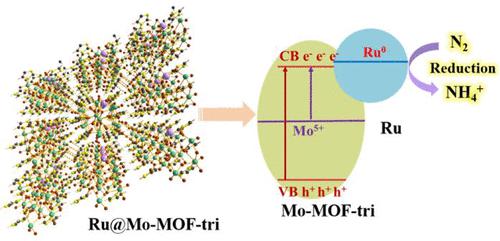当前位置:
X-MOL 学术
›
ACS Catal.
›
论文详情
Our official English website, www.x-mol.net, welcomes your
feedback! (Note: you will need to create a separate account there.)
Energy Level Engineering: Ru Single Atom Anchored on Mo-MOF with a [Mo8O26(im)2]4– Structure Acts as a Biomimetic Photocatalyst
ACS Catalysis ( IF 11.3 ) Pub Date : 2022-06-20 , DOI: 10.1021/acscatal.2c01756 Shuo Wang 1 , Ji-Jie Zhang 1 , Meng-Ya Zong 1 , Jun Xu 2 , Dan-Hong Wang 1 , Xian-He Bu 1
ACS Catalysis ( IF 11.3 ) Pub Date : 2022-06-20 , DOI: 10.1021/acscatal.2c01756 Shuo Wang 1 , Ji-Jie Zhang 1 , Meng-Ya Zong 1 , Jun Xu 2 , Dan-Hong Wang 1 , Xian-He Bu 1
Affiliation

|
Energy level engineering by controlling the defect level in the band gap and constructing a single-site heterojunction via MOF-based biomimetic catalysts brings out opportunities for photocatalytic nitrogen fixation. Herein, isolated Ru single atoms were successfully implanted onto well-organized Mo-MOFs with a [Mo8O26(im)2]4– structure to form Ruδ+-O3-Mo3 single-site heterojunctions. Both Ru doping level and Mo5+ defect level have been incorporated into the band structure of Mo-MOF simultaneously with enhanced visible-light absorption up to 700 nm. Ru@Mo-MOF-tri showed significantly higher photocatalytic nitrogen fixation activity than Ru@Mo-MOF-mono because of the higher amount of Ruδ+-O3-Mo3 active sites and bending down at the interface of Ru@Mo-MOF-tri heterojunction. DFT calculations based on a Ru single atom at the Mo-MOF-tri structure prove that the formation of the Ruδ+-O3-Mo3 single site with Mo5+ results in moving up of the Fermi level with a high electron energy; thus, the energy barrier is dramatically reduced for the formation of NNH* as the rate-limiting step of nitrogen fixation. The clear structure–activity relationship obtained in this work provides clues for designing single-site heterojunctions as biomimetic photocatalysts and regulating the energy band structures rationally, integrating the advantages of single atom metal and photosensitive MOF.
中文翻译:

能级工程:用[Mo8O26(im)2]4-结构锚定在Mo-MOF上的Ru单原子作为仿生光催化剂
通过控制带隙中的缺陷水平和通过基于 MOF 的仿生催化剂构建单点异质结的能级工程为光催化固氮提供了机会。在此,孤立的Ru单原子成功地注入到具有[Mo 8 O 26 (im) 2 ] 4-结构的结构良好的Mo-MOFs上,形成了Ru δ+ -O 3 -Mo 3单点异质结。Ru掺杂水平和Mo 5+缺陷水平已被纳入 Mo-MOF 的能带结构中,同时增强了高达 700 nm 的可见光吸收。与 Ru@Mo-MOF-mono 相比,Ru@Mo-MOF-tri 的光催化固氮活性显着高于 Ru@Mo-MOF-mono,这是因为 Ru@Mo- 的界面处有更多的 Ru δ+ -O 3 -Mo 3活性位点并向下弯曲。 MOF-三异质结。基于Mo-MOF-tri结构上的Ru单原子的DFT计算证明,与Mo 5+形成Ru δ+ -O 3 -Mo 3单位点导致费米能级以高电子能量向上移动;因此,作为固氮限速步骤的 NNH* 形成的能垒显着降低。该工作获得的清晰构效关系为设计单中心异质结作为仿生光催化剂和合理调节能带结构提供了线索,并结合了单原子金属和光敏MOF的优势。
更新日期:2022-06-20
中文翻译:

能级工程:用[Mo8O26(im)2]4-结构锚定在Mo-MOF上的Ru单原子作为仿生光催化剂
通过控制带隙中的缺陷水平和通过基于 MOF 的仿生催化剂构建单点异质结的能级工程为光催化固氮提供了机会。在此,孤立的Ru单原子成功地注入到具有[Mo 8 O 26 (im) 2 ] 4-结构的结构良好的Mo-MOFs上,形成了Ru δ+ -O 3 -Mo 3单点异质结。Ru掺杂水平和Mo 5+缺陷水平已被纳入 Mo-MOF 的能带结构中,同时增强了高达 700 nm 的可见光吸收。与 Ru@Mo-MOF-mono 相比,Ru@Mo-MOF-tri 的光催化固氮活性显着高于 Ru@Mo-MOF-mono,这是因为 Ru@Mo- 的界面处有更多的 Ru δ+ -O 3 -Mo 3活性位点并向下弯曲。 MOF-三异质结。基于Mo-MOF-tri结构上的Ru单原子的DFT计算证明,与Mo 5+形成Ru δ+ -O 3 -Mo 3单位点导致费米能级以高电子能量向上移动;因此,作为固氮限速步骤的 NNH* 形成的能垒显着降低。该工作获得的清晰构效关系为设计单中心异质结作为仿生光催化剂和合理调节能带结构提供了线索,并结合了单原子金属和光敏MOF的优势。











































 京公网安备 11010802027423号
京公网安备 11010802027423号